Blog
Archives
.
. . from 2012 to current
Wildlife
News Summaries
- Fortnightly
summary of local wildlife news
WEDNESDAY
AUGUST 31 - 2016
Emsworth
I had a stroll
around the local area this morning to see what was
about. I was pleased to see that the Skullcap
on the Lumley Stream wall outside No 3 Raglan Terrace
on Lumley Road was still in flower.
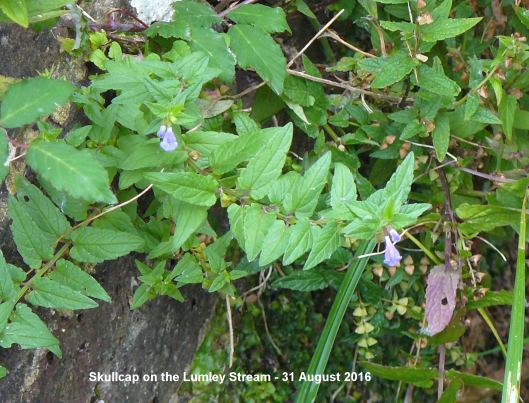
Going down Lumley
Road, I came across a group of what looked like
young Mallards feeding quite feverishly in the
water near the eastern side of Peter Pond. I wonder
what they had found that was so appetising?
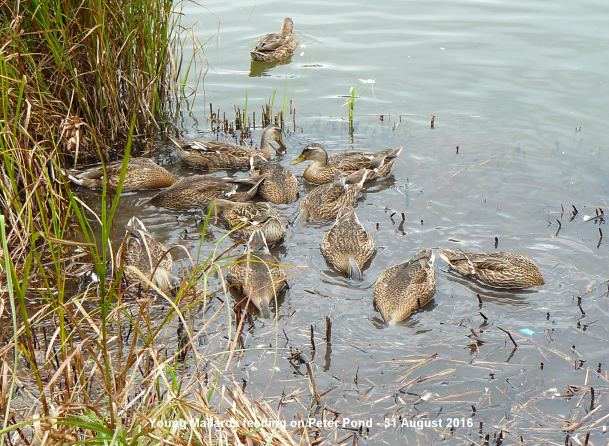
I counted 12
Coot on Slipper Millpond, all adults. They could
be the first of the autumn arrivals. Brendan Gibb-Gray
told me that the two Coot chicks that were on the pond
a couple of weeks ago had disappeared.
Italian
Lords-and-Ladies
Coming back
through Palmer's Road Copse I noticed the spikes of
bright red berries on the Italian Lords-and-Ladies
that has been growing on the river bank by the south
bridge for several years. The spikes appear to be much
larger than the more common Lords and
Ladies.

Its leaves are quite
distinctive in having creamy veins, though these come
earlier in the plant's growth. Here is a shot of the
leaves of the Italian Lords-and-Ladies taken in the
spring.
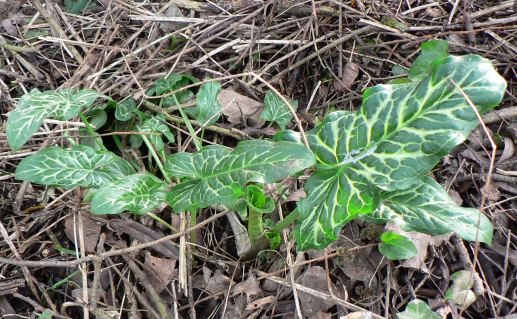
I am not sure, but I
suspect these plants in Palmer's Road Copse are
Arum italicum subsp.
italicum, which are usually found as
garden escapes, though, as we can see from the plants
on Brook Meadow, they can become fairly well
established in the wild. This subspecies was
cultivated in Britain by 1683 and was known from the
wild by at least 1905. It is popular in gardens, and
its distribution is probably increasing. It has a
Mediterranean-Atlantic distribution. There is also a
rare native Arum italicum though I don't
know how to distinguish that one from the subspecies.
Malcolm's
news
Malcolm
Phillips was on Brook Meadow this morning. He got very
interesting shot of a pair of Small White
butterflies about to mate with the female (below)
raising the end of her abdomen towards the male
(above).
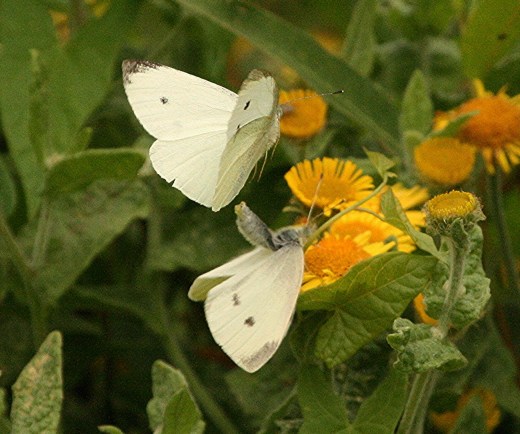
He also got this
excellent image of a Silver Y moth, which is
fairly common on Brook Meadow at the present. It is a
day flying moth and is common in gardens where it
feeds from flowers.
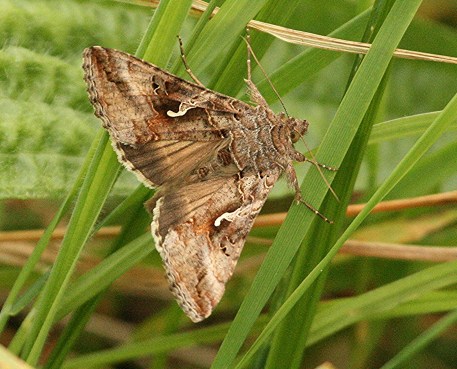
Butterfly Conservation
describe it as probably the UK's most common immigrant
moth. It is resident in the south of its range and in
spring variable numbers migrate north reaching as far
as Iceland, Greenland, and Finland with huge invasions
taking place in some years. In the British Isles
adults arrive in significant numbers from May onwards
with numbers dwindling in late autumn as they are
killed off by frosts. Some individuals fly south again
to winter around the Mediterranean.
TUESDAY
AUGUST 30 - 2016
Yellow
Rattle
Jill Stanley
has been on Brook Meadow taking close-up photos of the
Yellow Rattle seed heads. Here is one showing the
lace-like network of veins enclosing the seed
pods.
Jill explains: "The 'white things' are the actual seed
pods and they have black seeds inside them. The seeds
rattle within those pods, which then open for the
seeds to disperse. The outer lacy bits are the remains
of the sepals which, in the case of Yellow Rattle, are
formed into a kind of bulbous tube".

As it is partially
parasitic on grass, the seeds of Yellow Rattle have
been widely planted on Brook Meadow to help control
the growth of the coarse grasses. This has worked very
well in the main orchid area where Yellow Rattle is
abundant and grasses grow less tall and strongly, thus
allowing the emergence of other less strident flowers.
There is another form
of Yellow Rattle called Greater Yellow Rattle
due to its larger flowers. This is a very rare
grass-seed alien, which was introduced into the
British Isles through imported grass seed. We are very
unlikely to see any locally as it is described in The
Hants Flora as being 'extinct'!
Butterflies
Malcolm
Phillips was on the meadow this morning for a couple
of hours and managed to find two cracking butterflies.
Malcolm's photo of the Clouded Yellow shows all
the main features of this beautiful butterfly which
tends to be seen locally in late summer: yellow wings,
silver 'figure of eight' spots in the centre of the
hind wing and a dark spot on the forewing; green eyes
and pink legs. Clouded Yellow is a migrant butterfly
which cannot survive British winters. Malcolm's insect
will be an offspring of the spring migration from the
Continent.
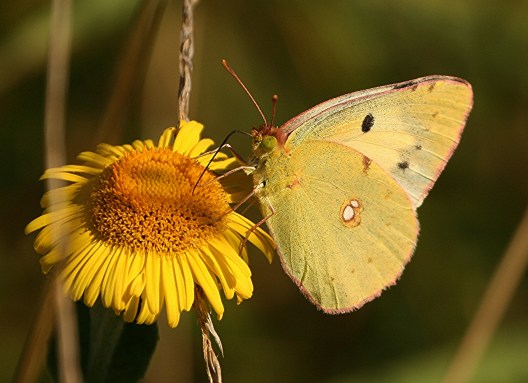
In contrast, Malcolm's
Small Copper is far from its best and has most
likely been on the wing for some weeks. However, it
was the first one recorded this year Brook Meadow.
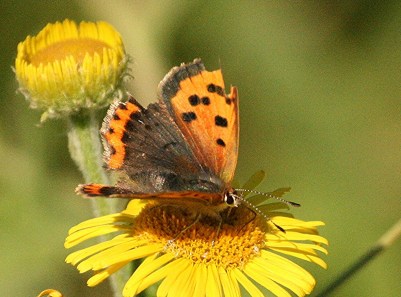
MONDAY
AUGUST 29 - 2016
Emsworth
Show
I spent most
of today at the Emsworth Show which, from what I can
judge, was a roaring success after two particularly
bad years. The weather was perfect, warm, but not too
hot and not a spot of rain.
I took along a basket full of wild flowers on the
front of my bike which I had picked this morning from
Brook Meadow. They included mostly late flowering
plants, like Common Fleabane, Hoary Ragwort and Wild
Angelica and twigs from Rowan, Alder Buckthorn,
Hawthorn, Oak, Ash and Osier Willow.
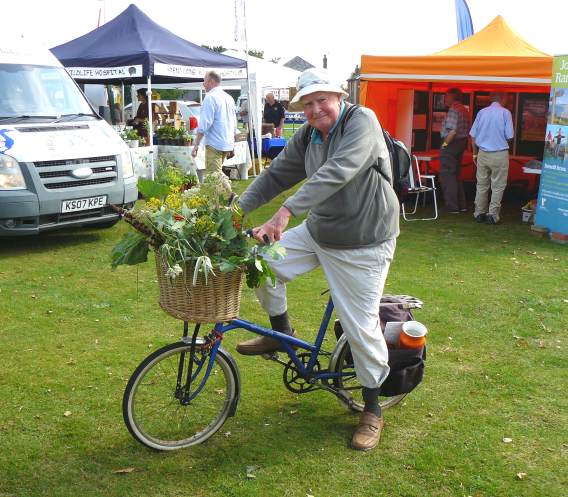
I had intended putting
them into vases, but when I arrived everyone said they
should be left in the basket on my bike where they
looked quite splendid. In fact, they attracted a lot
of attention with people stopping to ask questions
about them.
I thought the Brook
Meadow Conservation Group stall was as attractive as I
have ever seen it and in a much better position than
last year. Here is a shot of the front of the stall at
the start of the show manned by David and Maurice.
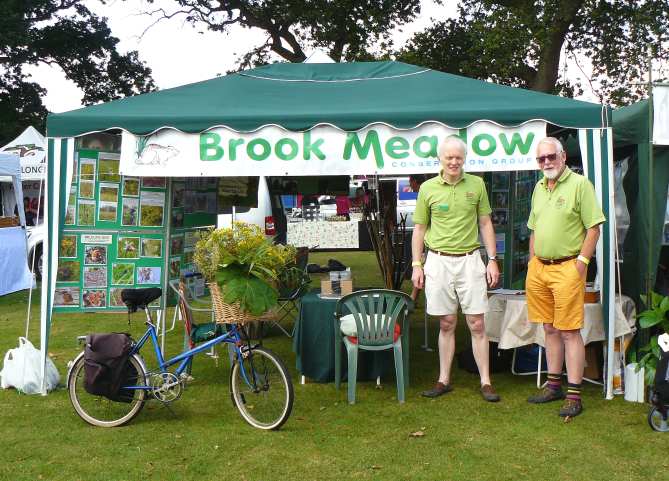
One innovation this
year was an invitation for people to vote for the
'people's postcard' from a series of four beautiful
photos produced by John Tweddle depicting the four
seasons of the year. Here are Jennifer and my wife
Jean discussing the merits of the four pictures. In
addition, a copy of John's postcard was given free to
every person renewing their subscription to the group.
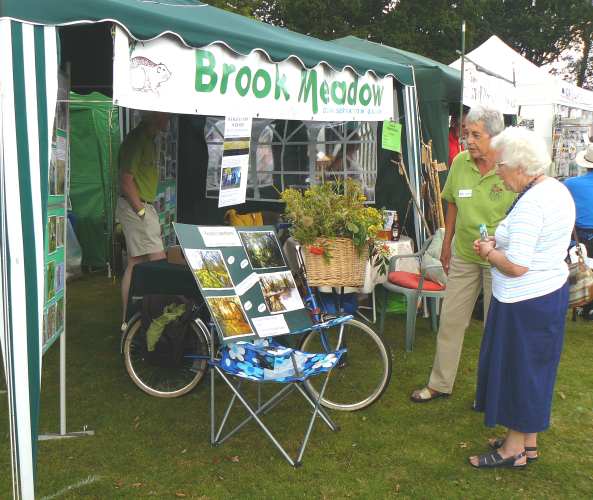
Maurice Lillie also
brought along for sale a variety of thumb sticks that
he had made from different species of tree, including
some from Brook Meadow.

Angle
Shades Moth
Chris Oakley
found this rather spectacular Angle Shades moth on one
of his tomato plants today. He also had one last year
on one of his indoor tomatoes. He wonders if these are
a food source?
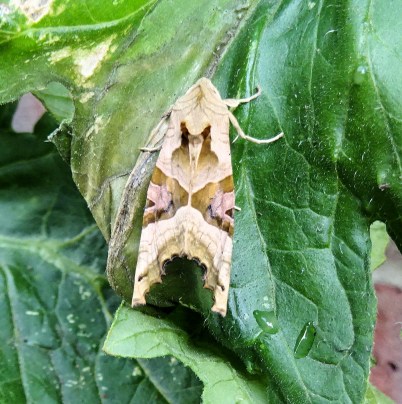
I have checked with
the RHS web site which says the caterpillars of Angle
Shades moth can feed on a wide range of wild and
cultivated plants and can be particularly damaging
when they eat unopened flower buds. As a non-chemical
control it suggests torch-light inspections of damaged
plants on mild nights for caterpillars which can be
removed by hand. The caterpillars can be placed on
wild plants such as nettle and bramble to continue
their life cycle. How very sensible!
Langstone
Mill Pond
Peter
Milinets-Raby popped down Langstone Mill Pond this
evening 6:40pm to 8:27pm - tide pushing in.
Little Egret roost: 6:55pm 28 in roost. First
30 minutes: 40 into roost. Second 30 minutes to sunset
= 66 into roost. Last 30 minutes to 8:25pm = 42 into
roost. Grand total 176.
Other birds seen: Kingfisher, 150+ Swallow into roost,
2 Teal.
Off shore: 8 Greenshank, 1 Black-tailed Godwit.
SUNDAY
AUGUST 28 - 2016
Brown
Argus
Ralph Hollins
informs me that the blue butterfly photographed by
Malcolm Phillips on Brook Meadow on Aug 26 that I
called a brown form of female Common Blue was , in
fact, a Brown Argus. Ralph points out the total
absence of blue in the wings and the presence of dark
spots in the centre of the forewing clearly indicate
that it is a Brown Argus.

To see the photos
showing this go to http://www.ukbutterflies.co.uk/species_similarities.php
and scroll down to the relevant section.
Malcolm also had a Brown Argus on Brook Meadow at
about the same time last year - on 29-Aug-15. This was
our 4th Brown Argus sighting on Brook Meadow.
Brown Argus is a local butterfly confined to the
southern half of England and the Welsh coast. They
usually occur on open chalk and limestone grassland,
where the caterpillar's main food, Common Rockrose, is
abundant. On other sites Common Stork's-bill and
Dove's-foot Cranesbill are eaten. It overwinters as a
caterpillar and has two broods, May-June and July-Aug.
Hedgehog
Debbie
Robinson was out on bat survey on Friday 26 Aug when
my dog found a hedgehog under the railway bridge at
the end of the Seagull Lane path. It curled up at her
approach. Although not strictly within the boundary of
Brook Meadow, interesting nevertheless. It probably
comes from the neighbouring gardens.
SATURDAY
AUGUST 27 - 2016
Malcolm's
news
Malcolm
Phillips walked round the meadow this morning and
managed, he says, "to find some birds for a
change".
The Grey Wagtail looks like a juvenile judging
from its whiter than usual flanks. An adult would have
more yellow. If it bred on the meadow that would be a
first which would be very good news. The Wren
might also be a youngster, though I gather adults and
juveniles cannot be reliably distinguished except in
the hand.
FRIDAY
AUGUST 26 - 2016
Malcolm's
news
Malcolm had a
reasonably successful morning on Brook Meadow. His
photos included a brown form of female Common Blue and
what looks like a Silver Y moth from the white mark on
its wing.
Malcolm's most
interesting find of the morning was a dead
Mole. Moles, of course, spend most of their lives
burrowing underground. However, in summer when the
ground is very dry Moles will come onto the surface to
seek food, ie worms which go deeper than Moles are
able to burrow. Malcolm's Mole is undamaged and could
be a youngster that tried its luck on the surface, but
probably died of natural causes. Does anyone have a
better explanation?
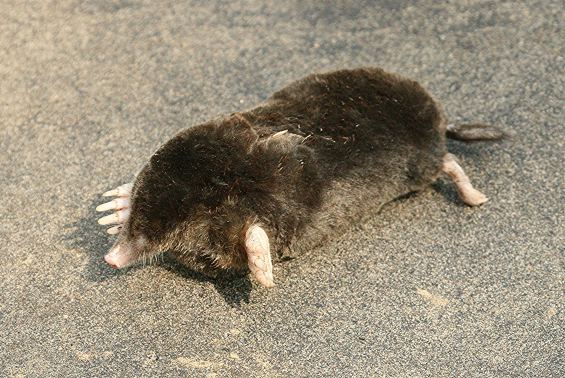
THURSDAY
AUGUST 25 - 2016
Cuban
Birds
Malcolm
Phillips did not have any local observations today, so
sent me photos of a couple of birds that he took in
his garden in Cuba. Cape May Warbler and Cuban Emerald
Hummingbird. Malcolm will have to be our Cuban
correspondent when he moves over there.
Lesser
Black-backed Gull
Thanks to Tom
Bickerton for pointing out that the Black-backed gull
taken by Brian Lawrence in flight yesterday was a
Lesser not a Great Black-backed Gull. The yellow legs
which can be clearly seen in Brian's photo are the
distinctive feature.
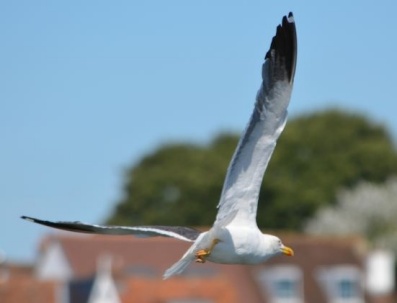
Osprey
on Thorney
Claire Power
went to Thorney today and found the Osprey that had
been posted on Going Birding sitting on a post
overlooking the deeps. Claire saw it from Thorney Road
just before you get to the army base checkpoint and
says a scope would be useful as it is a long way away.
Here is Claire's distant photo of the Osprey.
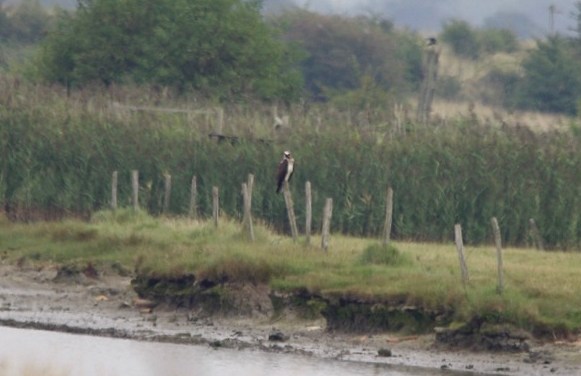
Ospreys tend to stop
off at the Deeps for a few days at this time of the
year on their way south from their breeding grounds
(in Scotland?) to their wintering grounds in Africa.
Claire also got a Kestrel on the cables and an early
passage Wheatear.
Osprey
at Arundel
Tony Wootton
had to go to Arundel yesterday and popped in to the
Wildfowl and Wetlands Trust reserve. "Walked in,
Osprey flew over ONCE, took picture, walked out, 15
mins max. Better than buying a lottery ticket." What a
cracking picture. Tony should win a prize at the
Emsworth Show. This will be another Osprey passing
through on its way south.
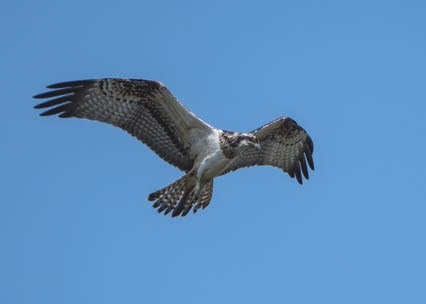
Pesticide
free campaign
Havant Friends
of the Earth has launched an online petition urging
Havant council to stop using products in public places
that contain glyphosate, a potentially carcinogenic
material found in products such as Roundup . The aim
is to build support towards putting a motion to the
full council to actively seek non toxic alternatives.
Please circulate to your networks and suggest they do
the same. To sign please click on the link . . .
http://goo.gl/Lne7SJ
It is easy. I have just done it. If you hate the idea
of pesticides being sprayed around the streets of
Emsworth like I do then sign up. They are very bad for
the environment and bad also for people!
WEDNESDAY
AUGUST 24 - 2016
Langstone
Mill Pond
Just back from
a family holiday to Belarus, Peter Milinets-Raby was
back on his home patch again this lunchtime (Noon to
1pm - tide sort of pushing in).
Not much around. Some waders off shore with 44 Dunlin,
6 Bar-tailed Godwit, 3 Grey Plover, 3 Black-tailed
Godwit, 115+ Redshank, 2 Sandwich Tern, 3 Common
Gull,
On the pond: Mute Swan family with 8 juveniles. And,
39+ Little Egrets roosting.
Peter's rarest bird in
Belarus was this family group of Whooper Swans. Since
1995, the species has bred with 2 to 10+
pairs.
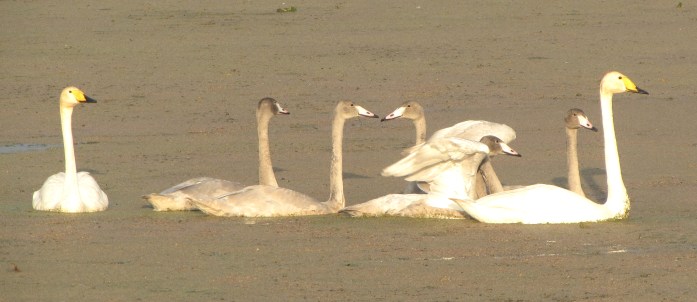
Other good birds
included Red-backed Shrike, Short-toed Eagle, Lesser
Spotted Eagle, Icterine Warbler and White Stork. Peter
has made a YouTube video of some of the wild flowers
in Belarus.
Link: https://www.youtube.com/watch?v=igf5D9Ashkg
Brian's note: A few I
spotted off the top of my head while watching the
video: Tansy, Golden Rod, Reed Canary-grass, Oxeye
Daisy, Bladder Campion, Stitchwort, Hare's-foot
Clover, Agrimony, Cornflower, Yellow Rattle, Common
Toadflax, Yarrow, Ragwort, St John's-wort.
Other
local news
Brian Lawrence
had a walk from Nore barn to Emsworth harbour
yesterday and found a Great Black-backed Gull
there I have attached a picture of it in flight. It
could be one of the Slipper Millpond pair?
Tony Wootton went looking for a Wryneck on Farlington
Marshes but had no luck finding it. However, he did
get a lovely Wheatear as a reward for his
efforts.
Wider
news
For the second
year running, Common Cranes have successfully
raised chicks on a Suffolk RSPB reserve. See . . .
http://www.birdguides.com/webzine/article.asp?a=5871
With Common
Swift numbers in decline, the RSPB and two
building companies have created a new swift nest box
in a brick format which can be easily fitted in any
new home. See . . . http://bit.ly/2befOxB
TUESDAY
AUGUST 23 - 2016
Emsworth
(west)
Jean and I had
a walk along Western Parade this morning as far as
Nore Barn. The tide was out so there was little to see
in the harbour apart from gulls and Oystercatchers. We
heard a Curlew calling in the distance.
Plants along the shore included masses of Spear-leaved
Orache and Sea Beet. Here is a particularly large
plant of Sea Beet growing on the rocks.
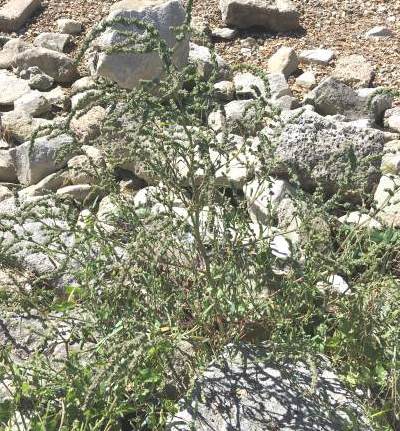
Most impressive was
the Tamarisk in full flower in one of the long gardens
off the Western Parade path.
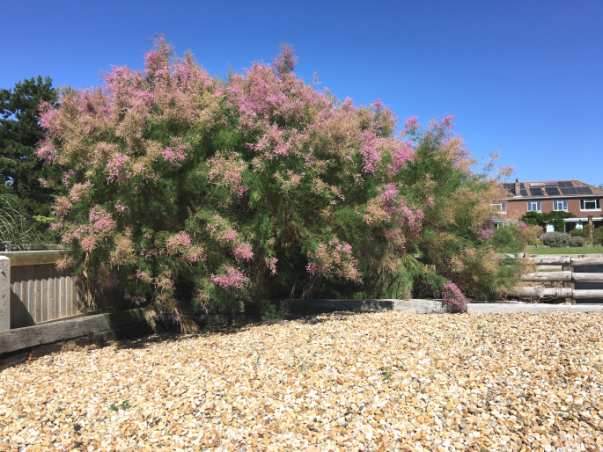
A Mute Swan family
with 3 cygnets was on the eastern harbour. This is
most likely to be the family from this year's nest on
Slipper Millpond; last seen there on July 26.
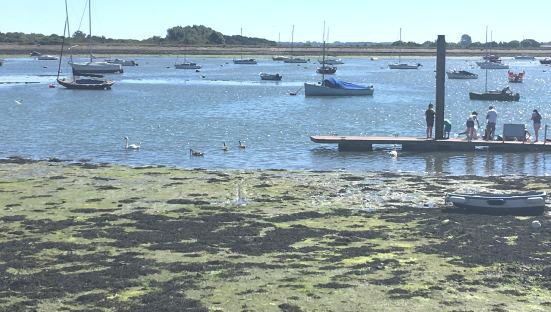
Malcolm's
news
Malcolm Phillips had what he called 'a very
disappointing 3 hours on the meadow today with nothing
much moving so only two very ordinary photos for you'.
Yes, Malcolm, very ordinary for you, but still great
images of our beautiful birds that most people would
be delighted with.
Malcolm also had some
very special news to convey. While he was away on his
6 month holiday in Cuba, he got married! I have seen
photos of his new wife, an attractive Cuban lady, and
the house that they have been renovating in Cuba.
Malcolm hopes to obtain Cuban citizenship so he can
move out there eventually. We shall certainly miss his
contributions to our Brook Meadow wildlife gallery,
but wish him well in his new life. He says he will be
around the for the next couple of weeks while he sorts
things out and, as you will see from this blog, has
been on the meadow every day doing his very patient
wildlife watching.
MONDAY
AUGUST 22 - 2016
Brook
Meadow
Hoary
Ragwort is now in full flower on the north meadow,
creating a sea of bright yellow flowers.

The flowers are highly
attractive to a variety of Bumblebees as are those of
Hemp Agrimony which are in flower in the same
area.
There are lots of Meadow Grasshoppers low down
in the grass. These are largely wingless creatures and
do not fly, unlike most other grasshoppers.
I was pleased to find
a good growth of Common Orache in the same spot
as last year, just inside the south gate onto the
south meadow. It is mainly distinguished from
Spear-leaved Orache which grows mostly on the Lumley
area, by the lower leaves which have basal lobes
pointing forwards.
Malcolm's
news
Malcolm
Phillips sent me a selection of his photos as he
walked round Brook Meadow this morning and on to West
Thorney. Here are the best of his shots. Small White
and Southern Hawker from Brook Meadow and Little Egret
and Small Tortoiseshell from Thorney.
SUNDAY
AUGUST 21 - 2016
Stansted
Forest
Jean and I had
a stroll through east Stansted Estate this morning,
avoiding the noisy 'Hot Rods' show that was taking
place on the lawn in front of the house.
We were interested to find what I think is Chicken
of the Woods fungus growing in a cavity on the
fixed wooden stump preventing traffic at the far end
of the path in front of Stansted House.

We were interested to
see a clump of Mugwort in full flower on the
edge of the eastern track. Although this is a common
plant, one does not often get the opportunity to see
it in flower.
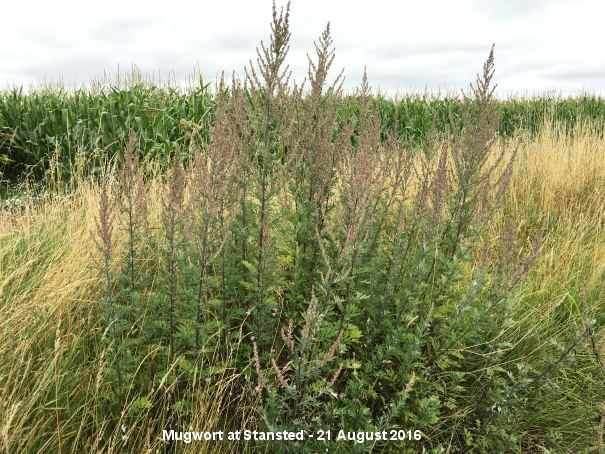
Its flowers, as shown
in the close up photo of a spike taken from a Stansted
plant, are in spikes, small and rayless, rather like
Groundsel, with dark red petals just showing.
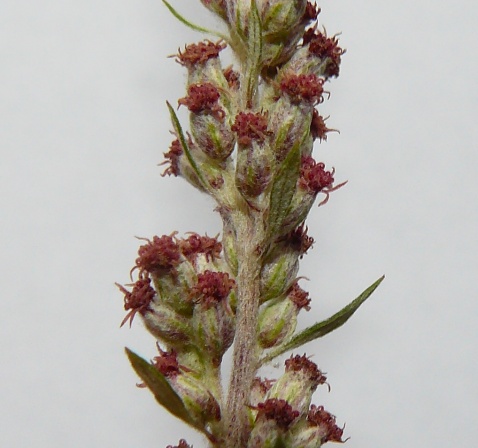
House
Martins
Caroline
French is near the end of her British Trust for
Ornithology House Martin survey in Westbourne and has
some very good news. She says of the 13 original nests
three have second broods with well-developed chicks
which look nearly ready to fledge. Here are some
photos that Caroline took of the chicks. Aren't they
just sweet.

As for the other
nests, one has chicks which seem younger, but are just
becoming visible near the nest entrance, three others
have activity around the nest, suggesting likely
second nesting attempts, but another one has almost
completely disintegrated following successful first
brood and shows no signs of an attempt to
re-build.
One nest is showing almost no activity following a
successful first brood, although the nest is intact.
The home owner says he sees the odd bird entering but
doesn't think a second attempt is underway. Caroline
has seen no activity on the last four visits (ie for
about a month). Another nest had fledged chicks still
using it 10 days ago but showed no activity today; two
more nests were really just remains of last year's (or
even a previous year's) nest and have seen no activity
this season. Finally, there was another old nest,
about half-complete, but has seen no activity this
year. So, it looks like at least seven nests so far
are having second breeding attempts. That is
brilliant, particularly as we have not a single House
Martin nest anywhere in Emsworth. Well done Caroline.
SATURDAY
AUGUST 20 - 2016
Brook
Meadow
Malcolm
Phillips had a couple of hours going 'round and round'
the meadow today looking for any wildlife of interest.
He sent me a batch of photos from which I have chosen
a few. First, under the south bridge Malcolm saw this
large 14ins Brown Trout with what looked like a
fungus, or some sort of damage, on its back. What
could have happened to it?
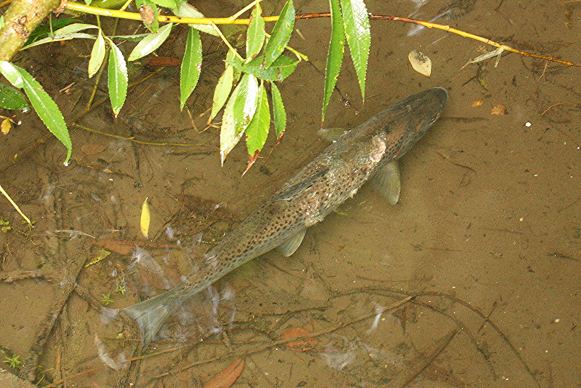
He also captured a
Meadow Grasshopper and what I assume is a
Common Wasp feeding on an umbellifer flower
head.
Finally, Malcolm
presented this trio of spent Teasel heads,
which could well win a prize at the Emsworth Show.
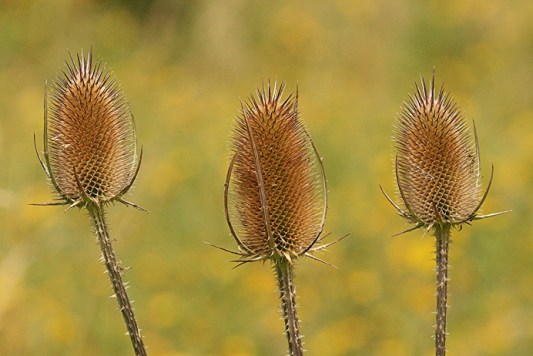
FRIDAY
AUGUST 19 - 2016
Brook
Meadow
The weather
was so awful today that I did not manage any wildlife
watching apart from the back garden where the
highlight was a visit from a small family of
Long-tailed Tits to the fat balls. No photo.
The bad weather did
not deter the redoubtable Malcolm Phillips from
venturing out with his camera. He got a couple of
young birds: Blackbird and Wren - very
good news for breeding success on the meadow.
Malcolm also got a
Green-veined White butterfly which have been
surprisingly elusive on the meadow this year. Finally,
he came up with what looks like some Common Ink Cap
fungi, the first recorded on Brook Meadow this
year. Well done, again Malcolm.
THURSDAY
AUGUST 18 - 2016
BROOK
MEADOW
Work session
I went over to
the meadow this morning mainly to take photos of the
regular Thursday work session for the web site. The
session was led by Mike with 10 volunteers. Jobs
included clearing around the Hazel saplings by the
north bridge, moving wood chippings to the Seagull
Lane path, strimming paths in the south meadow,
trimming the willow hedge on the river bank which had
grown into a mini forest, cleaning the signcases and
litter picking.
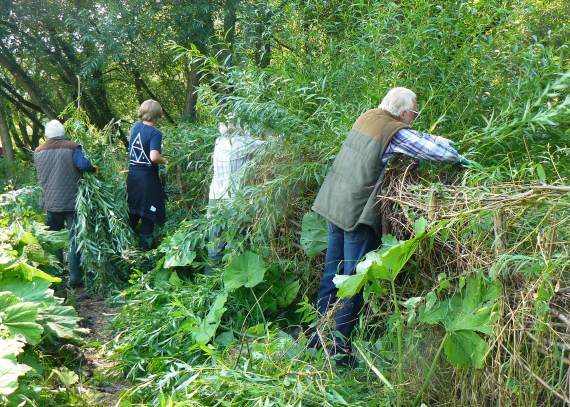
A warning notice was
placed near a wasp nest on the north path.
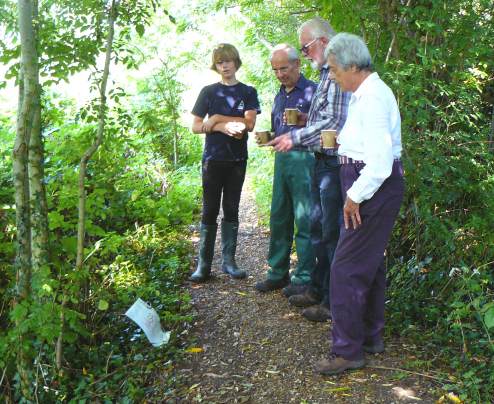
The report and more
photos of the work session can be seen on the new
Brook Meadow web site at . . .
http://www.brookmeadow.org.uk/conservation-work/
Wildlife
observations
A reptile
survey is underway. A large number of black felt
mats have been placed around the meadow by the
ecological team that arranged the reptile relocation
earlier in the year . The aim is to see how many have
survived.
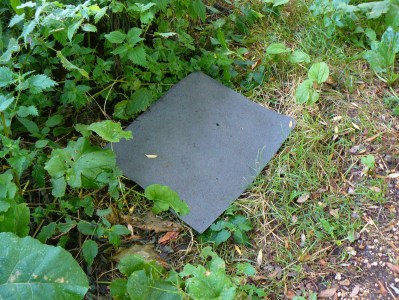
Kingfishers are
returning to the harbour areas after their breeding
season. Pam Phillips saw one on the Lumley Pool
yesterday and Michael Probert saw one on the river
near the north bridge this morning. They are usually
best seen around the millponds in winter. Here is one
that Malcolm Phillips caught in flight earlier in the
year.

It was interesting to
see the regrowth of Butterbur on the meadow
below the main seat only a couple of weeks after it
had been mown.

The Rowans on
the east side of the north meadow are covered in red
berries.

The Wild Angelica
flower heads are highly attractive to a variety of
Bumblebees, including this fellow with bulging pollen
sacs on its legs.
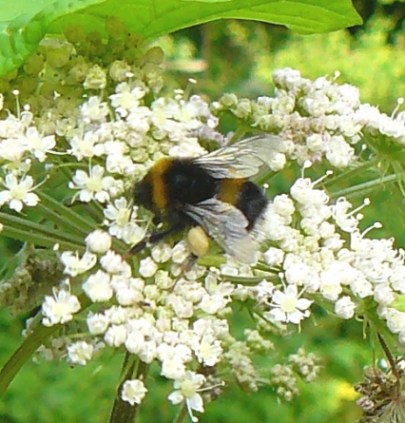
Butterflies
Malcolm
Phillips was on the meadow again today and got some
excellent images of butterflies. Comma, Holly Blue,
Painted Lady and Red Admiral.
WEDNESDAY
AUGUST 17 - 2016
Emsworth
News
Walking
through Brook Meadow this morning, I was surprised to
see a single flowering plant of Common Ragwort
on the Lumley Path. Unlike Hoary Ragwort, Common
Ragwort is a rare plant on the Brook Meadow site. This
is the first record of the year and, in fact, the
first since 2014. How strange as Common Ragwort is a
prolific plant on roadside verges, etc. It just has
not caught on on Brook Meadow.

Passing Peter Pond I
noticed that the Mallards are now in their eclipse
plumage with males looking like females.
A Mallard family of mum with 6 ducklings was on the
pond near the bridge. This is probably the same family
that Mike Wells saw on Aug 9, but there was no sign of
the yellow duckling that caught Mike's attention that
day.
The Coot appear to be
nesting again on the north raft on Slipper Millpond.
No sign of the Mute Swan family or the Great
Black-backed Gulls which left some time ago. Golden
Samphire is flowering well on the bridge
overlooking Slipper Millpond.

Coming back through
Brook Meadow, I watched a number of Common Darters
flying above the surface of the river immediately
beneath the south bridge, red males and males and
females in tandem dipping into the water. I managed to
capture a couple mating while perched on a Greater
Plantain flower spike in Palmer's Road Copse.

Malcolm
is back!
Malcolm
Phillips has just got home from Cuba this morning and
had a walk round the meadow. Among the photos he sent
me was this cracker of a substantial Brown Trout in
the river.
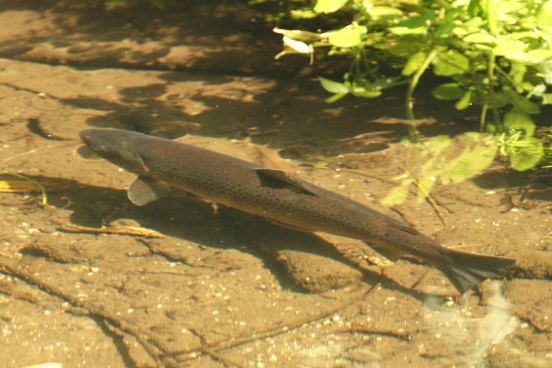
Malcolm also got our
first Clouded Yellow of the year. Welcome back!
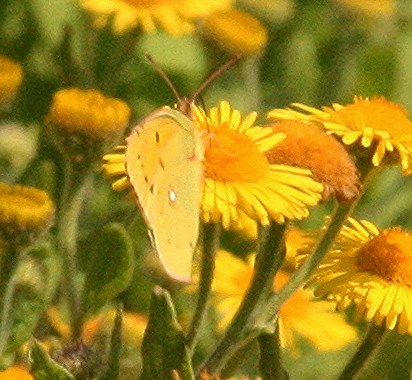
Sinah
Common
Mark Wagstaff
visited Sinah Common today hoping to see the Common
Hawkers that Tom Bickerton saw there on July 31st, but
they were not about. However, there were lots of other
wildlife to delight in, including Migrant Hawkers
(left) for certain and one Southern Hawker (right).
Mark also stumbled on
an unusual blue butterfly - given the time of year and
location he thinks it must be the 'blue' form (as
opposed to brown) of the female Common Blue.
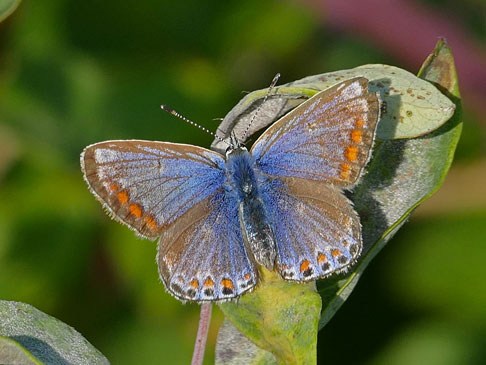
Thorney
Deeps
Tony Wootton
went down the west side of Thorney Island to the Great
Deeps hoping to see the Kingfishers that Ros Norton
saw there on Aug 12. An hour of waiting produced one
lightening flash of blue, but that was all. However,
Tony was not too disappointed as he got Painted Lady,
Clouded Yellow, Chiffchaff and Whitethroat on the
journey.
MONDAY
AUGUST 15 - 2016
Brook
Meadow
I had a stroll
through the meadow on the way to the shops this
morning. I checked the damage to the flood defence
concrete bag wall in the north-east corner which
Jennifer Rye informed me about. The lads have wrenched
off yet more bags and chucked them in the river. How
do they manage to do this?
I used my iPhone to
snap a bright hoverfly on a Hogweed flower head. It
looks like Myathropa florea - often seen
on Brook Meadow. It is also known as Dead Head Fly
from the pattern on its thorax. iPhone is not bad as
an emergency camera for close-ups.
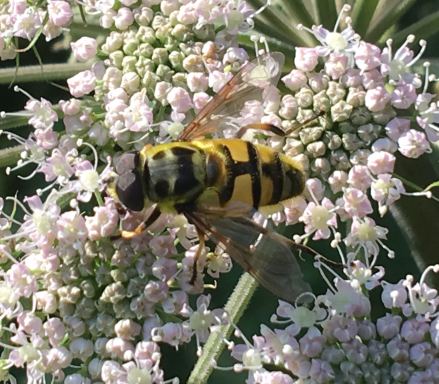
Tom's
news
Tom Bickerton
went to Farlington Marshes on Sunday mainly for the
dragonflies, but the ponds are in such poor state
there were hardly any. But he did get a nice
Blue-tailed Damselfly. He came across a pair of mating
Common Blues.
Tom also found what
was left of one this year's juvenile Black-headed
Gulls. He thought it was a Peregrine kill, with
the spine still attached to the wings. The falcon had
snipped off the legs and they were neatly placed under
the wing, but no head.
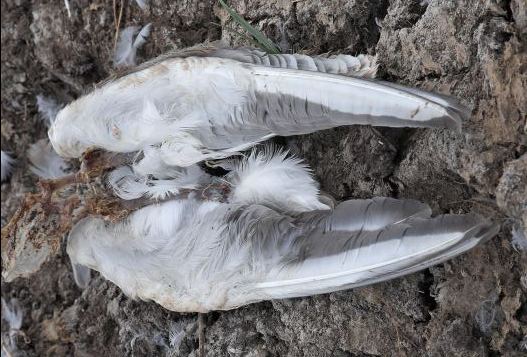
Elaine's
news
Elaine Abel
noted a few things she had seen on her travels this
last couple of weeks...
1) The wild flowers at the top of Kingley Vale are
probably the best I have seen them in years.
2) I haven't seen any White Admiral butterflies in
either Hollybank Woods or Havant Thicket this year. I
note with sadness that both large Buddleia bushes in
Hollybank Woods have gone so that can't have helped,
though I am sure that isn't the reason.
3) We have had 4 hedgehogs in our garden (Brook
Gardens) this last couple of weeks. One adult and what
appears to be 3 individual youngsters...i.e. they
don't all come along like a mother hen and
chicks....and they love dried mealworms.....only feed
them about every third night so they don't get
dependent.
Rose-ringed
Parakeet
Christopher
Evans writes that Ring Necked Parakeet (aka
Rose-ringed Parakeet) is Britain's only naturalised
parrot with a distribution in Surrey, Kent and Sussex.
He got this shot yesterday in Victoria Park in the
East End of London. He says they have also colonised
The Hague where they are regular visitors to his
brother's garden. He wonders if any are seen any down
our way. I do occasionally get sightings, but they are
rare. If anyone knows their whereabouts please let me
know.
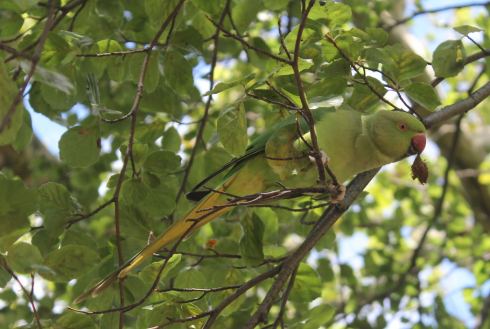
SUNDAY
AUGUST 14 - 2016
Brook
Meadow
I fancied a
gentle stroll through the meadow this afternoon. It
was hot and sultry and I was vaguely hoping for
butterflies, but I only saw a Red Admiral and a few
whites. Where have they all gone?
I walked through the orchid area on the north meadow
which presently is a forest of Hoary Ragwort,
but not a Cinnabar caterpillar to be seen anywhere.
Are they particularly scarce this year?

I tried to pursue a
Dark Bush-cricket through the dense vegetation,
but only got its rear end clearly indicting it was a
male. I also got a glimpse of its yellow underside.
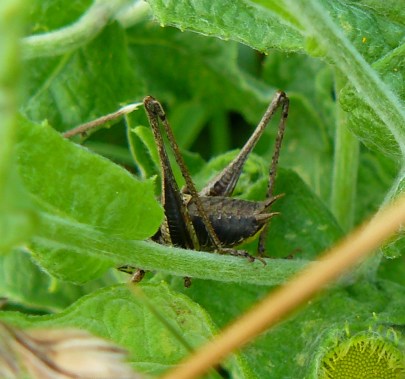
Coming back through
Palmer's Road Copse I got chatting to a chap from
Horndean who wondered if I was John Goodspeed!
Actually, that's not the first time I have been asked
that. John is quite famous for his Havant Nature Notes
which he posts around the area.
Coming home through North Street Car Park behind the
Fire Station I came across a good growth of what I
assume is Guernsey Fleabane coming up through
the tarmac. This plant was first recorded in this
country in 1974 as an introduction from South America,
but has spread rapidly especially in urban areas. One
sees now it everywhere.
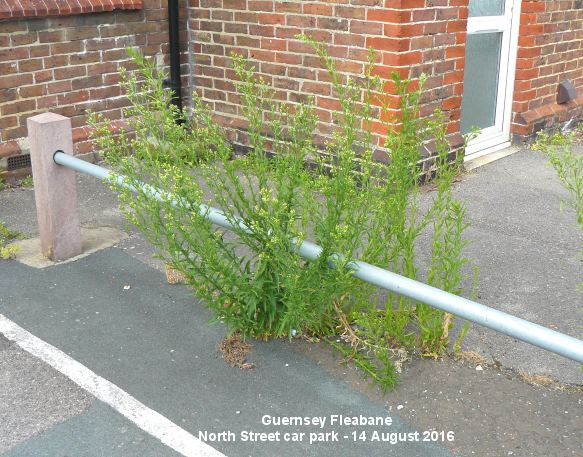
Thirsty
Woodpecker
Tony Wootton
had this Green Woodpecker turn up for a drink at his
bird bath yesterday evening. A young lady he thinks?
The Buddha looks a bit miffed!
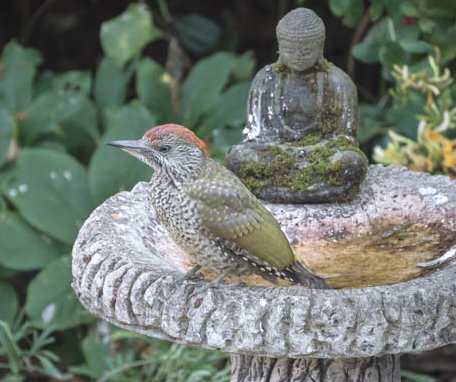
SATURDAY
AUGUST 13 - 2016
Waysides
News
The Greater
Burdock at the end of the path from Washington
Road to the Recreation Ground is going from strength
to strength with more plants than ever this year,
though I totally missed the flowering. Did it ever
happen?
The Wild Clary
on grass verge at the northern end of Christopher
Way, which has been mown yet again by the Norse
cutting team a couple of weeks ago, is back and
flowering! What an amazing plant this is. But please
Mr Norse, if you are listening, give it a chance.
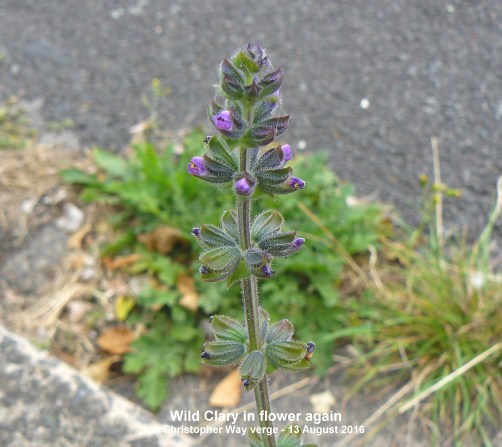
The wayside to the
north of Emsworth Railway Station continues to delight
train commuters using the access ramp with its galaxy
of pure wild flowers and not a planted one in sight!
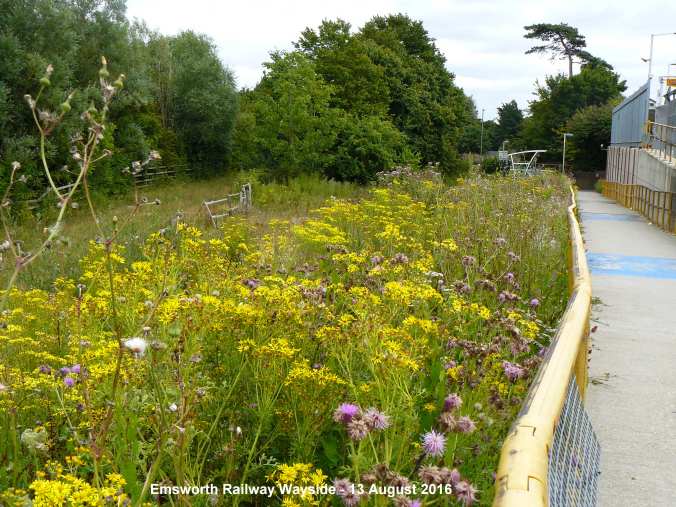
Hoary Ragwort
is particularly colourful and is attracting Bumblebees
like this Bombus terrestris. Also
attractive are the seed heads of willowherbs
with their plumes of long silky hairs and thin
pods.
Other
news
Yesterday, Ros
Norton saw 2 Kingfishers at the west side of Thorney
Great Deeps by the gate. They were very active,
calling, flying and fishing for a long time. Ros also
saw a Clouded Yellow butterfly nearby.
Tony Wootton got this
Pond Skater with mites at Thursley common on
Aug 9. From Wikipedia I gather these are likely to be
Water Mite larvae which act as ectoparasites of Pond
Skaters.
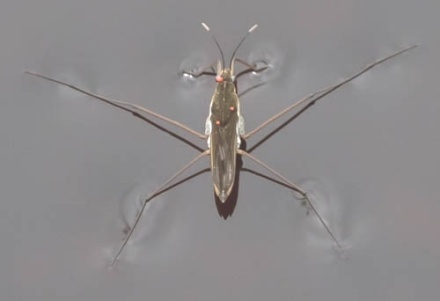
TUESDAY
AUGUST 9 - 2016
Hornet
Mimic Hoverflies
Ralph Hollins
thinks the Hornet Mimic Hoverfly photo in yesterday's
blog was not Volucella zonaria as I
thought, but the smaller species called
Volucella inanis. Ralph points out that
V. zonaria has a brownish front half to
its abdomen whereas V. inanis has a
clear yellow abdomen and also has narrower black cross
bands with longitudinal black lines forming a 'dotted
line' spine (see page 207 of Chinery's of Collins
Guide to Insects). The insect on yesterday's blog has
the characteristics of V. inanis whereas
the Aug 2 photo shows the darker yellow abdomen,
broader cross bands, and absence of the longitudinal
black partial lines of V zonaria. Here are the two
insects for comparison with V. zonaria
on the left and V. inanis
(yesterday) on the right.
For more info see . .
http://www.opalwestmidlands.org/volucella_hovers/Volucella.html
Yellow
Duckling
Mike Wells was
interested to see a bright yellow duckling among a
conventional brood of Mallard ducklings in the
south-east corner of Peter Pond this afternoon. It is
not all that unusual to get different colour ducklings
in a large brood, reflecting a mixed parentage.
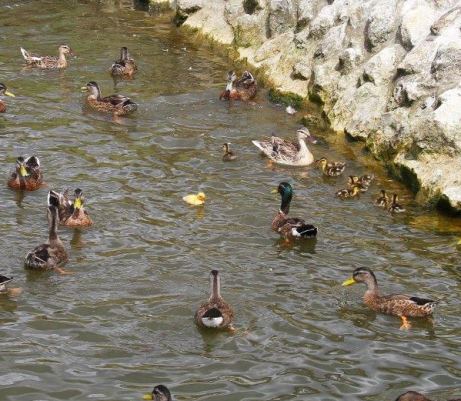
Stansted
wildlife
Tom Bickerton
popped over to Stansted on Sunday (Aug 7) and expected
to see bigger numbers of insects.
"I was pleased to get most of the butterflies, but
could help but notice how poor this year has been for
species I would expect to see in profusion. I went
there to see the White Admiral but they were but they
never going to stop and pose. I expect the hawkers
probably are around the southern part of the forest
near the pond.
Bird wise, again thin, most of the migrants had flown
south, or were moulting Ravens were very active and we
counted 4 individuals. A family of Buzzards were there
too with two young this year. I was hoping to see the
Hobby pair hunting, but there were no Martins,
Swallows or insects in the air."
Here is a
selection of Tom's pics: Green-veined White,
Silver-washed Fritillary, Wasp Spider and Raven.
MONDAY
AUGUST 8 - 2016
Brook
Meadow
I had a stroll
around the meadow this morning. Saw nothing special
until I reached the far south east corner of the south
meadow where a few handsome Wild Angelica
plants have been spared in the recent clearance by
the Environment Agency.
Several insects were feeding on the large flower heads
including a Hornet Mimic Hoverfly
(Volucella zonaria). This was my second
sighting of this impressive insect, the first being in
Palmer's Road Copse on Aug 2. The Hornet Mimic
Hoverfly lives up to its name in terms of its size and
colouring, but does not sting. It became established
in Britain in the 1940s and before that it was thought
to be rare. It has very much a southerly
distribution.
Scanning the edge of Palmer's Road Car Park I spotted
the first Balm of the year. I usually find this
lemon smelling plant in this area, though its position
nearer the recycling bins is changed from previous
year.
Hornet Mimic
Hoverfly . . . . . . Balm
Sadly, the
Broad-leaved Everlasting-pea has failed to appear in
its usual spot on the Seagull Lane patch. The massive
growth of other plants was clearly too much for it
this year.
SATURDAY
AUGUST 6 - 2016
Alver
Valley
Tony Wootton
reported on this morning's walk by the Havant Wildlife
Group through Alver Valley in Gosport. See the Havant
Wildlife Group web page for the full report at . . .
http://familyfellows.com/hwg-walk-reports-2016.htm
Heather Mills sent me
two photos of grasses from this morning's walk which
they could not identify. My best guess is that they
are Small Wood-reed (Calamagrostis
epigejos). I stand to be corrected!
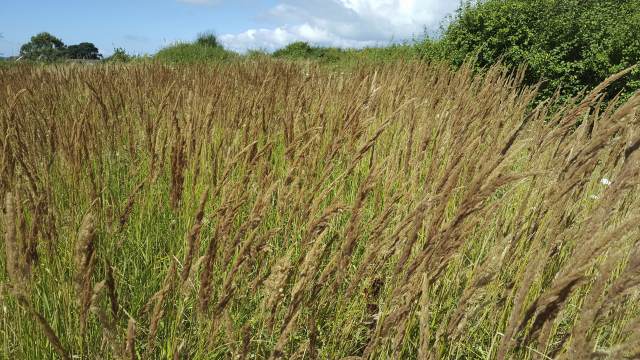
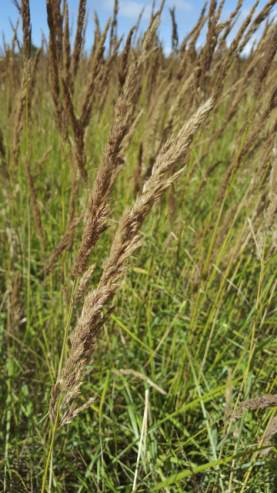
FRIDAY
AUGUST 5 - 2016
Annual
cut
I called into
the meadow this morning to see Martin Cull who was on
the second day of the annual cutting of the
grassland.
I took a short video of Brian cutting the north meadow
which I have posted onto YouTube.
The link to the video is . . . https://youtu.be/tL_zSaoT07I
Pollarding
The pollarding
of the tall willows on the west side of the River Ems
behind the Artec factory is now finished, but lots of
hefty branches have fallen across the river which need
to be removed. Maurice Lillie is negotiating with the
Environment Agency about clearing them as they could
well contribute to water flow problems as well as
affecting the river habitat for Water Voles and other
wildlife.
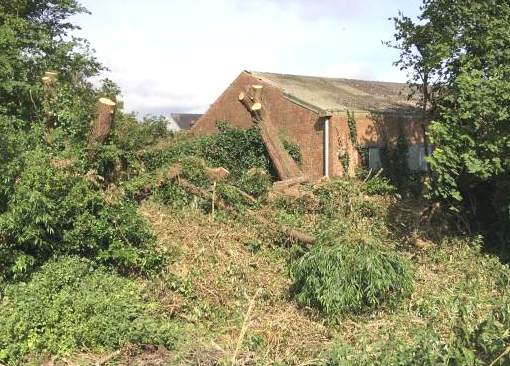
New
gate
As planned the
Environment Agency has erected a new gate at the
bottom of the steps at the southern entrance to the
south meadow.
For more details on
all these three projects and photos go to the new
Brook Meadow web site at . . . http://www.brookmeadow.org.uk/conservation-news/
Westbrook
Stream
As I was
passing through Bridge Road car park this morning I
found three members of the Environment Agency clearing
the Westbrook Stream of several large flower pots full
of soil that had been fly-tipped in the river. They
were responding to a phone call from a member of the
public who had seen the pots which were partly
blocking the stream.

Small
Copper
Brian Lawrence
had a walk on Hayling Island by the golf club up to
the ferry and got this cracking photo of a Small
Copper. This is likely to be from the second (August)
brood, though in warm summers a third or even fourth
brood may emerge, flying well into October.
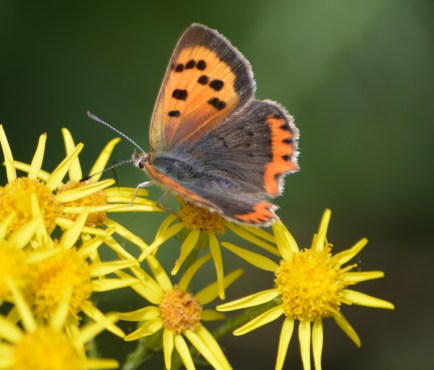
THURSDAY
AUGUST 4 - 2016
Young
birds
Barrie Jay
continues to get a good selection of young birds in
his Waterlooville garden. Here is his latest -
Long-tailed Tit and Green Woodpecker.
WEDNESDAY
AUGUST 3 - 2016
BROOK
MEADOW
Martin Cull
made a start on the annual cut of the grassland today.
He will continue early next week. This will be done in
line with the policy of mosaic cutting with some areas
being cut and others left uncut. The more ecologically
sensitive areas, such as the orchid area in the north
meadow and the Lumley area will be cut later by the
conservation group when seeds have set. Martin will
also collect the arisings from the cut areas and dump
them in designated parts of the meadow. Here is Martin
with his bright red tractor.
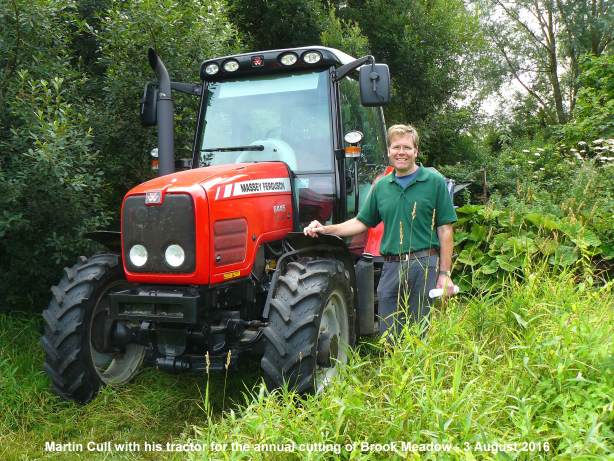
For a full report and
more photos of the work go to the new Brook Meadow web
site at . . .
http://www.brookmeadow.org.uk/current-news/
I had a quick look
around the area of the centre meadow before Martin cut
it. This area is now looking really good and could
become one of the special wild flower areas for more
careful treatment in the future. Water Mint was
flowering very well throughout the area. I also found
several flower spikes of Amphibious Bistort, a
plant which notoriously very rarely flowers, at least
here on Brook Meadow. This is probably the best
flowering I can recall. Unfortunately, you will not
see it as it will have been cut by Martin today!
There are, in fact,
two forms of Amphibious Bistort: the terrestrial form
which we have here on Brook Meadow which is much less
floriferous than the aquatic one which grows in water.
Here is an example of the aquatic form in flower on
Petersfield Lake taken on a visit on June
27th.

I was also pleased to
get my first Common Blue butterfly of the year,
a male feeding on Common Fleabane. This is quite late
to have the first sighting of this attractive
butterfly.
Pollarding
The tree
surgeons were back on the meadow pollarding the
willows along the west bank of the river behind the
factories. Maurice told me the work was stopped
temporarily due to the Artec factory being on holiday.
This photo shows one of the chaps clearing away cut
branches.
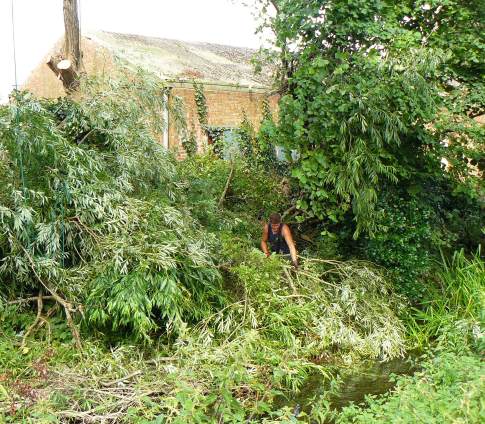
TUESDAY
AUGUST 2 - 2016
Waysides
News
I had a walk
around some of my local waysides this morning with
light drizzle in the air.
The Greater Burdock plants at the end of the
path from Washington Road to the Recreation Ground are
looking fine, though not quite in flower.
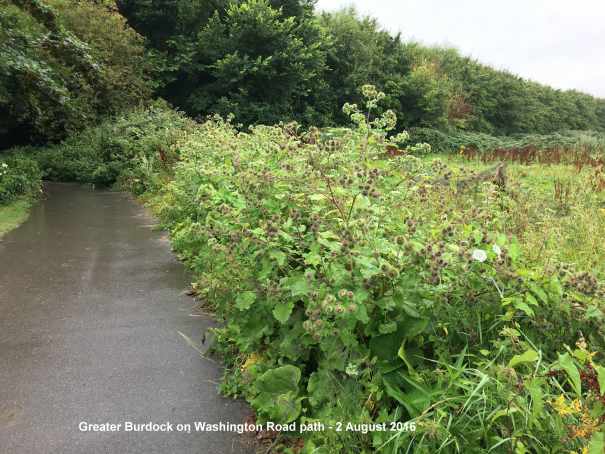
The grass verge at the
northern end of Christopher Way has been mown
again removing virtually all traces of the Wild Clary
that was growing when I was there 2 weeks ago on July
14th. I wrote to Jayne Lake of Norse (HBC) asking if
the verge could be spared in the next cut, but the
message clearly did not get through. However, I
explained the situation to a Norse employee who was
parked near the verge. He was sympathetic and actually
got out of his lorry to have a look at what remained
of the plants. Although he does not cut verges himself
he promised to pass on the message to those who did.
It is probably too late for another flowering this
year, but at least it might alert the cutting team to
the presence of the plants. Fingers crossed!
The
Wild Clary verge is underneath the first green lamp
post by the Norse lorry.
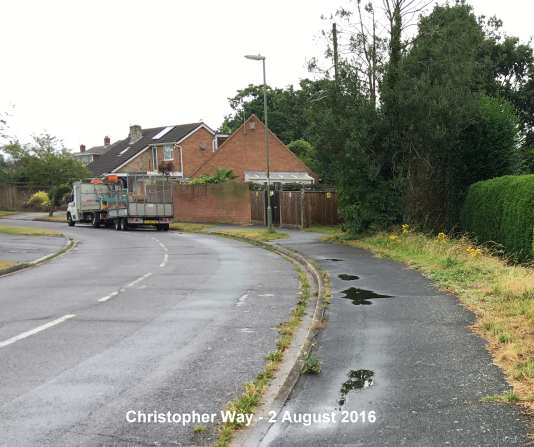
Stone Parsley is
abundant on the wayside at the junction of New
Brighton Road and Horndean Road.
The Railway
Wayside is a blaze of colourful flowers from the
access ramp to the north of the station - note all are
wild, none planted!
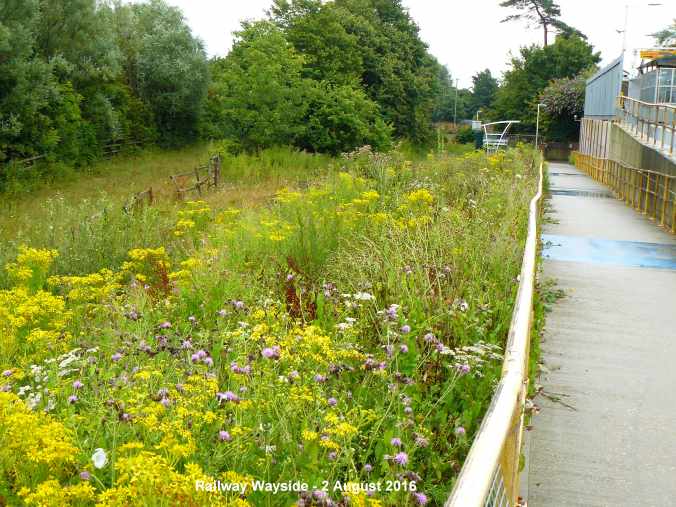
The flowers include
Marsh Woundwort, Common Ragwort, Hoary Ragwort, Stone
Parsley, Common Toadflax, Hemp Agrimony, Yarrow,
Common Knapweed, Hoary Willowherb (?), Wild Carrot,
Hedge Bindweed, Bristly Ox-tongue, Black Medick,
Common Fleabane.
Marsh
Woundwort . . . . Hemp
Agrimony
Peter
Pond
I went out for
another walk this afternoon and was astonished to find
another good growth of Wild Celery on the east
side of Peter Pond. It is no more than 50 metres away
from the other Wild Celery plants I discovered on the
Dolphin Creek wayside. Both are in brackish habitat
and both just over the border in West Sussex. The
mystery is how I could have missed these plants as I
have walked and surveyed this pond so often over the
years? Could it have only recently arrived? The grid
ref for the Peter Pond plants is SU 75275 05862.
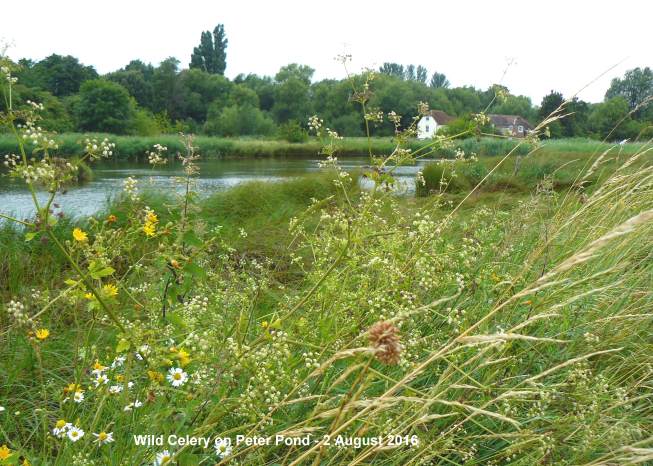
Two Mallard
families were on the pond with one and 8 ducklings
respectively. They are making hay now the Great
Black-backed Gulls have gone.
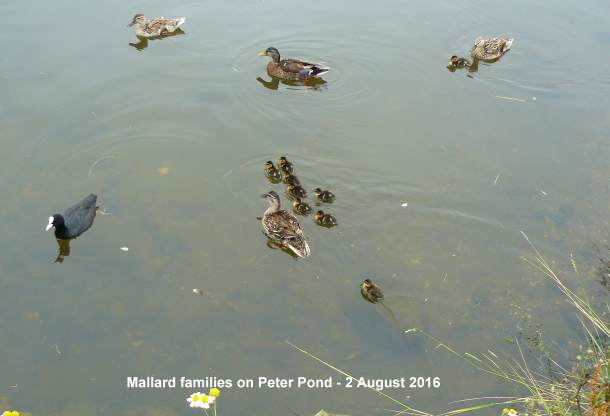
Hornet
Mimic Hoverfly
While walking
back home through Palmer's Road Copse, I happened to
spot a very large and colourful fly feeding on Hogweed
flowers. As I watched the insect, it occasionally took
off like a shot, flying very fast round and round for
a second or two, before returning to the same flower
head.
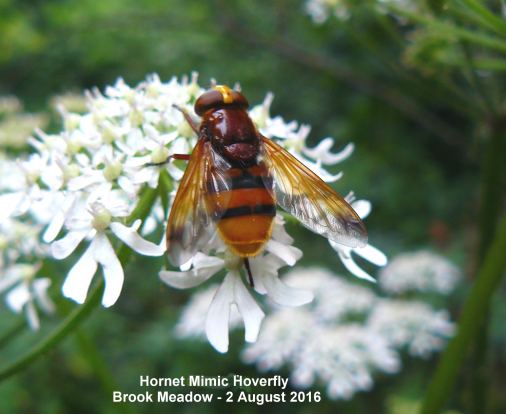
I thought at first it
was a Hornet, then decided it was probably a colourful
Horse-fly. However, I have now been told that it is in
fact a hoverfly called - Volucella
zonaria, also known as the Hornet Mimic
Hoverfly.
It is most frequently seen in urban areas and even in
cities, and particularly along the south coast. It is
active May to November peaking in August. Adults visit
flowers. The larvae have been found in wasps
nests.
This species became established in Britain in the
1940s and before that it was thought to be rare. It
has very much a southerly distribution with most
records coming from south of a line from the Severn
Estuary to The Wash, however it seems to be expanding
its range.
Salterns
Quay
Eric Eddles
who lives near Baffins Pond took a walk to see how the
sea defences were progressing on the Eastern Road. He
took this shot of what remains of what was one of his
favourite places to watch birds. I have also had some
good birdwatching from that quay. Now, it's gone!
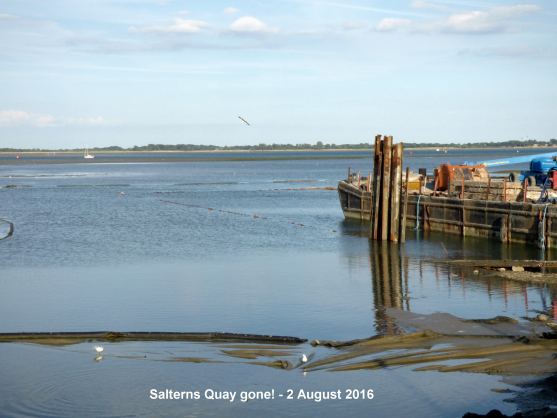
Tom's
news
Tom Bickerton
popped over to Sinah Common on Hayling Island on
Sunday (July 31) for the Purple Hairstreaks in the
stunted oaks. They were there, but reluctant to come
down. Best place was the entrance to the Golf Club Car
Park. He says you'll need a longish lens to get them,
they weren't that high in tree, but beyond his
camera's range. He also saw lots of dragonflies and
managed to get a shot of a Common Hawker but
the rest were just too quick. The Bedeguar gall
which grows on roses was there too.
Tom went onto
Portsdown Hill and found some Chalkhill Blues
and got this nice shot of a Nettle-leaved
Bellflower.
MONDAY
AUGUST 1 - 2016
Dolphin
Creek wayside
I had an
interesting walk along the path beside Dolphin Creek
at the end of Queen Street this morning. This is one
of our official waysides, though the notices have long
since disappeared.
I was puzzled by some plants at the northern end of
the wayside with spikes of pale mauve flowers. They
were clearly Toadflaxes, but which one? I was
initially inclined towards Pale Toadflax until I
examined the flowers more closely and discovered that
the spurs below the flowers were long and curved
suggesting a very pale Purple Toadflax. The spurs on
Pale Toadflax would have been short and straight.
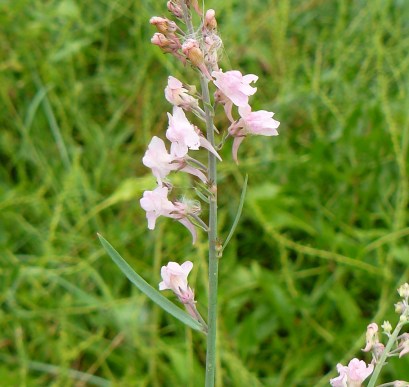
A bit further along
the wayside before you get to the seat are some more
puzzling plants. These are umbellifers with shiny
green leaves and tough ridged stems sprawling over the
ground. They have multiple flowering heads both at the
top of the stems and in the leaf axils.
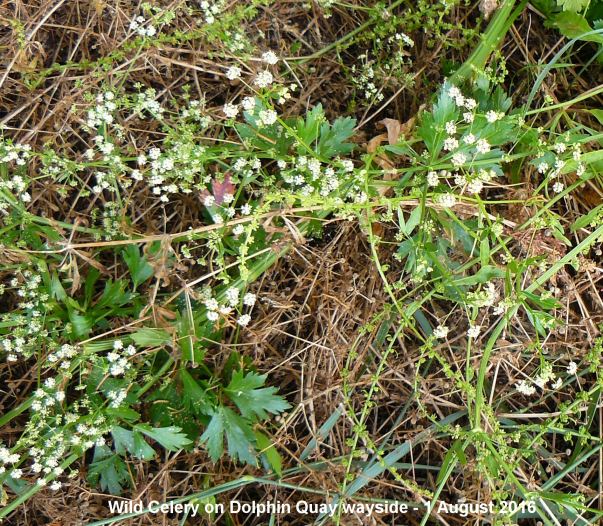
After much
deliberation, I finally nailed them as Wild Celery
(Apium graveolens) which I have only
seen once before - in a roadside ditch while carrying
out a BSBI tetrad survey with John Norton at Northney
on 10-Jul-2011. This is certainly a waysides first and
maybe a first for Emsworth? The Hants Flora describes
it as 'very local', found in brackish marshes and
creek banks on the coast, but not inland. So, the
habitat on Dolphin Creek is right, as this path is
frequently flooded with sea water at high water.
This photo is taken
looking north along the Dolphin Creek path towards the
Old Flour Mill. The Wild Celery were on the left
further along the path. The photo shows the fine
display of Perennial Sow-thistle with large
bright yellow flowers.
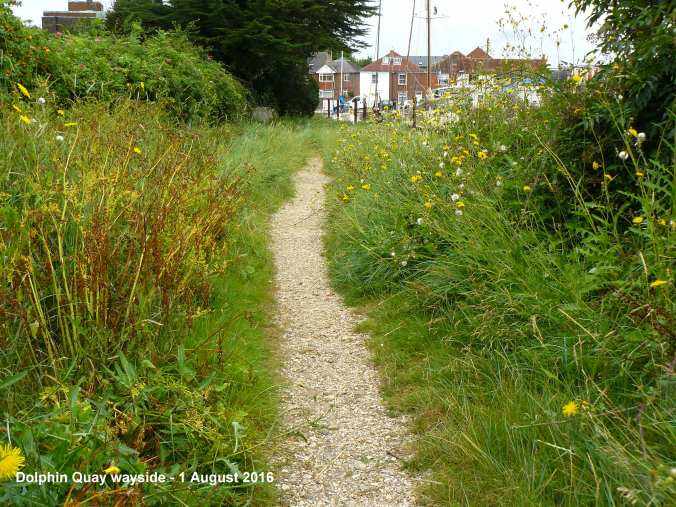
I also stopped to
admire the tiny red flowers of Knotgrass
adorning the edges of the path.
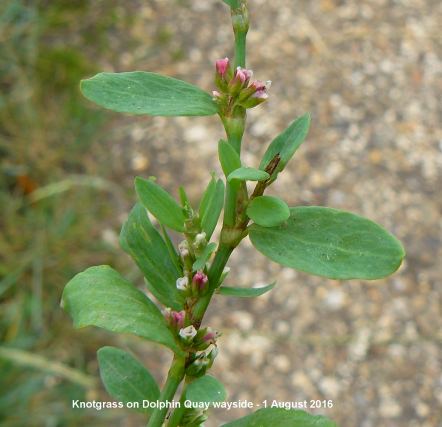
Emsworth
East Beach
I went down
onto the shingle beach to the east of Emsworth town.
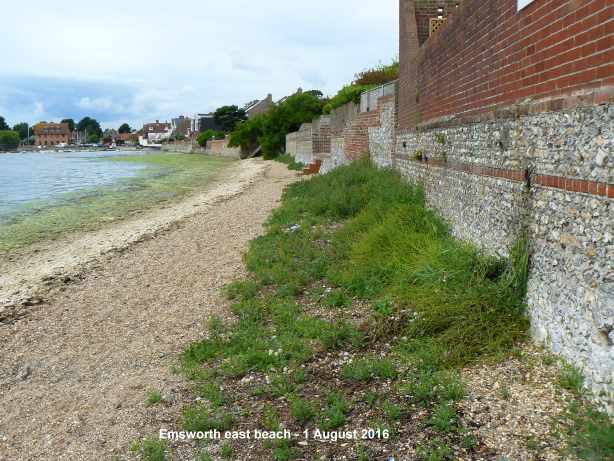
I checked several salt
tolerant plants growing there including masses of
Spear-leaved Orache, Sea Beet a Groundsel along with
some Grass-leaved Orache and Sea Mayweed on the wall.

Spotty
Starling
One of the
young Starlings that regularly visit my fat ball
feeders in the back garden has a very spotty chest. In
fact, when I first saw it I thought it was a Song
Thrush though I have not seen one of those for ages. I
managed to get this shot of it feeding on one of the
fat ball feeders.
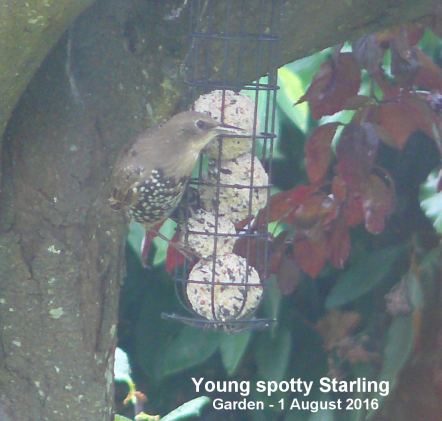
For
earlier observations go to . . July
17-31